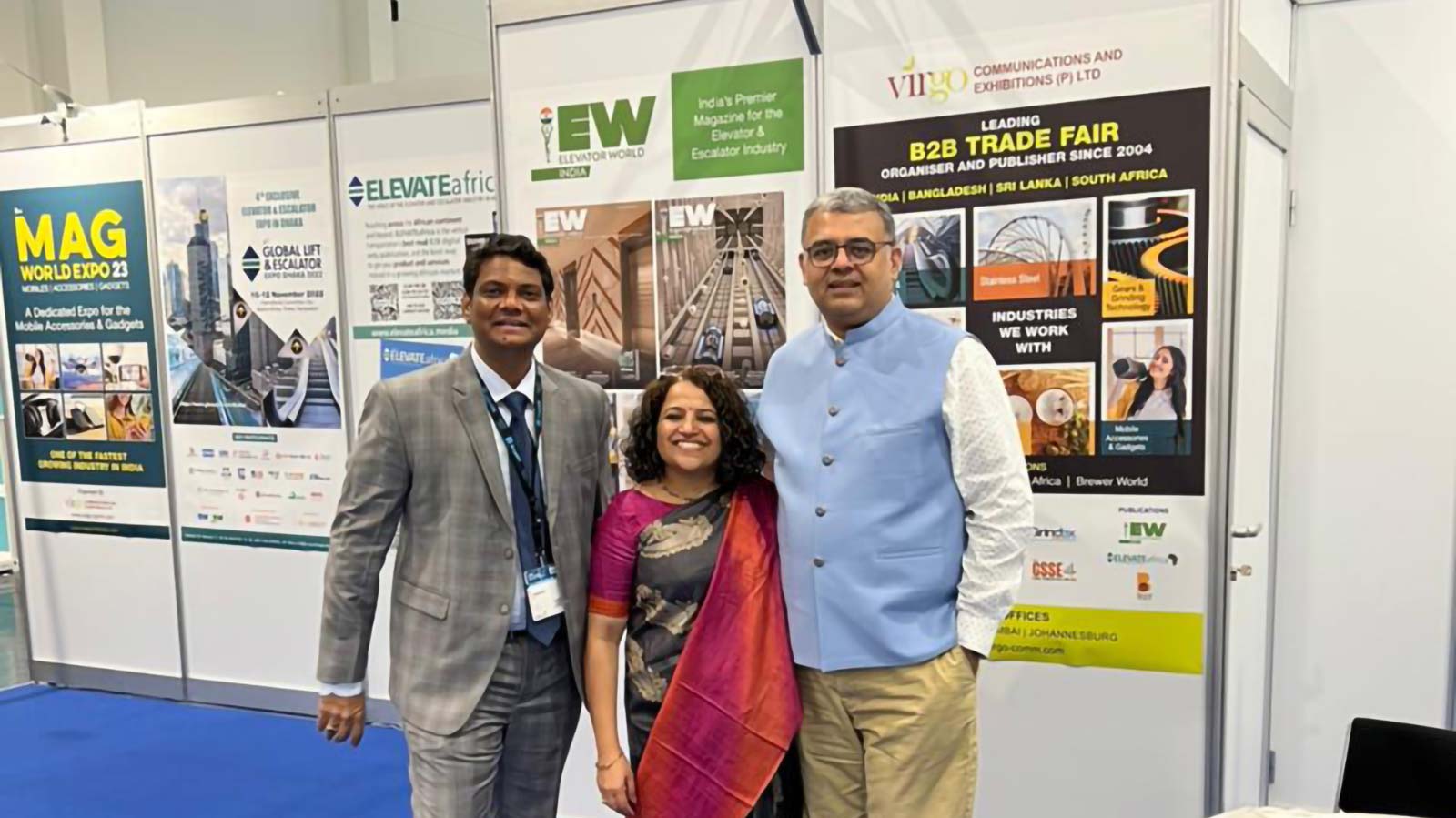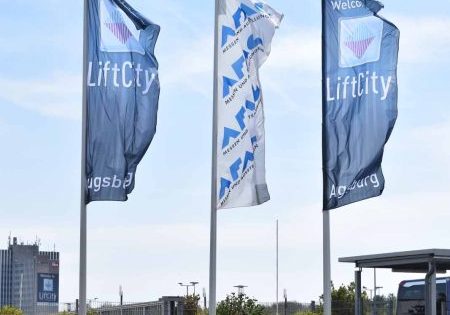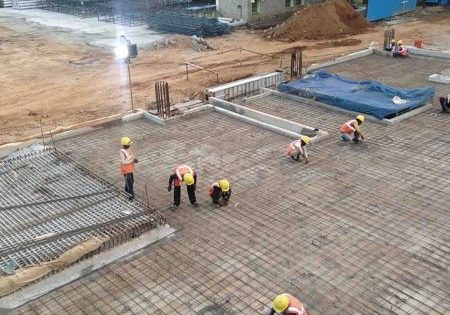Indian Insights
Aug 4, 2022

Team Virgo makes impact at Interlift 2022 in Augsburg, Germany.
Participants at Interlift 2022 in Augsburg, Germany, were happy to once again interact in person with the ELEVATOR WORLD India core publishing team of Anitha Raghunath and G. Raghu at the Virgo Communications & Exhibitions Pvt. Ltd. Booth No. 2140, Hall Two. They were joined at the booth by Krishna Kumar Ravi, president and CEO of PAPL Corp., India’s leading vertical-transportation (VT) planning, engineering and independent inspection company and a senior member of the EW India editorial team, to share insights on the Indian VT industry and elaborate on the implications of key market trends.
Ravi also gave a presentation titled “Global Accessibility, Security & Hygiene Standards for VHT Systems in Public Buildings — India Perspective” at the event’s VFA Forum. With India’s changing skyline and increasing number of high rises, VT is extremely important. The population of the country, the footfall public buildings expect and the fact that a system has to be handicapped-friendly were highlights of the presentation.
In his introduction, Ravi shared noteworthy figures: The world sees an average of 250 babies born every minute, he said, which is roughly equivalent to 360,000 a day and a whopping 130 million a year. The current world population is about 7.5 billion and is likely to touch 11 billion by 2050. India will be the most populous country by then, overtaking China, where the population is stagnating.
Stating that 15% of the world population lives with disability of some form or another, he extrapolated that, with 5% to 6% disability in India, the country has roughly 70 to 80 million disabled people. Declaring that it is a huge challenge to ensure an inclusive ecosystem without a top-down approach, he quoted former UNICEF Executive Director Henrietta Fore: “Exclusion is often the consequence of invisibility.”

Ravi highlighted that DEPWD – The Department of Empowerment of Persons with Disabilities (which is also referred to as Divyangjan), under the Ministry of Social Justice and Empowerment, Government of India, works toward empowering and including persons with disabilities into the mainstream. Stating that this is a “society for all,” he underlined that “an inclusive, safe, sustainable and clean world is a civilized world.”
Pointing out that India has a growing economy with a 2022 GDP forecast at 9.4% and 2023 GDP projection of 8.4%, Ravi then commenced his presentation, underscoring that the construction industry in this country is growing at a rate of more than 15% with top private equity funding. Most Fortune 500 companies have operations or offices in India, and there is a steady increase in high rises, as well as public infrastructure.
Ravi then posed the question, “Is India very different from the rest of the world?” The answer, he explained, is both yes and no. India is different in terms of its diverse culture and demography. Forty-six percent of its population is in the 15-44 years age group, and 60% of its population is in the 15-64 years age group. It has a very large English-speaking population. The aspects where it does not differ are technology absorption, aligning with International Organization for Standardization (ISO) standards, ratifying the United Nations’ Convention on the Rights of Persons with Disabilities (UNCRPD) and being a welfare state.
Emphasizing that, in a globalized world, opportunity and responsibility share equal perspectives, Ravi underlined that building meaningfully ethical products and providing services that are inclusive of people, societies and cultures worldwide is extremely important. The key ingredients for a responsible design include convenience, dependability, environmental sustenance, assurance and hygiene, which must now be included since it is the most sought-after requirement in view of the COVID-19 pandemic that put the world under siege. New innovations have been made to address this aspect and already-existing solutions have been adopted for the VT industry to meet hygiene requirements, which can be classified into contact related and space related.
According to him, the need of the hour is for creative thinking and innovation to align with the advanced ecosystem and be attractive to the world clientele, since innovation is one of the key drivers of change. Highlighting the perpetual scenario of people crowding at VT facilities in public buildings across India, including airports, railways, seaports, convention halls, stadiums, malls, cinemas, amusement parks, exhibition centers and government offices, Ravi declared that these need to be treated differently and not like other private usage buildings, such as residential buildings and office complexes. Private buildings with their captive users and visitors have in-house standards to manage accessibility, security and hygiene, depending on the extent of exposure and usage. On the other hand, public buildings attract people from different backgrounds, cultures, races, nationalities and purposes who have perceived accessibility, security and hygiene standards of differing levels.

The global public expects global standards so that, wherever they go, they encounter similar systems. The currently available standards cover only safety (including accessibility) and performance; not security and hygiene, which has greater significance, especially post-pandemic, Ravi observed.
Drawing the audience’s attention to the fact that accessibility standards are neither adequate nor standard across the globe, he explained that a common standard ensures an even proposition of requirements worldwide; a global standard ensures easier evaluation and assessment of a property or premises.
Ravi pointed out that, even though many countries are signatories to UNCRPD, its implementation in respective geographies lacks uniformity and clarity. Post-pandemic implementations on hygiene and its technicalities address only short-term mitigations and lack long-term, sustainable solutions.
An inclusive, safe, sustainable and clean world is a civilized world.
— PAPL Corp. President and CEO Krishna Kumar Ravi
Moving on to India’s approach to accessibility, Ravi began with the government’s intervention in formulation of rules and listed some of the specific requirements:
- Buildings above two floors should have elevators
- Parking for disabled persons should be provided closer to the elevator lobby
- Ramps should be mandatory for access to buildings
- Braille markings are a must for elevators, as are voice guidance or announcements inside the lift regarding the floor number, door opening and door closing
India has promulgated the Rights of Persons with Disabilities Act (RPwD), a common standard that ensures requirements for PwD are implemented. Most requirements, according to Ravi, are in line with international standards including minimum sizes for lifts, signages, locations and heights of operating devices suitable for PwD. Standards clearly specify the visual-, touch- and sound-based requirements, as well as access to and from an elevator (see box).
He also listed other standards in India; IS 15330:2020 Code of Practice for Installation and maintenance of lifts for handicapped persons, NBC 2016 and ISO 21542:2011 relating to Building Construction – Accessibility and Usability of the Built Environment, which delineates a set of requirements and recommendations concerning construction, assembly, components and fittings.
Proceeding to the security considerations, Ravi opined that they should address factors related to intrusion, violence and theft, as most security risks can be mapped to one of these three. VT systems need to be capable of addressing and mitigating risks related to security by ensuring authorized access, surveillance and hygiene.
The presentation concluded with Ravi summing up the situation by stating that innovations will continue in the field to address accessibility, security and hygiene. The public is becoming more aware of their rights as transparency increases and the fear of infection leads to demand for solutions. Governments are being held more accountable. Hence, they are addressing these issues. Easy access to global technology is helping in this direction, he said, before opening the floor for questions.
Representing India and one of the leading publications that is dedicated to presenting the latest about the VT industry in the country and from across the world, the EWI team found it gratifying to be a part of such a reputed event.
Harmonized Guidelines and Standards in India
Outlining the harmonized guidelines and standards for universal accessibility in India, Ravi shared the following 10 points:
- The minimum size of a lift should be 1,900 mm x 1,900 mm for all new establishments. The lift door should have a clear opening of no less than 900 mm and contrast in color from the adjoining wall. There should be no difference in level between the lift door and the floor surface at each level. The gap between the lift door and building floor should not exceed 12 mm.
- The door shall open automatically and remain open at least 5 s. Time of closing of an automatic door should be more than 5 s., and the closing speed should not exceed 0.25 m/s. If there is a user in the doorway, the door shall automatically reopen and shall not produce a force greater than 135 N. Sensors should be positioned at two levels to ensure they detect lower items.
- Call buttons should be installed at a height between 800 mm and 1,000 mm. Call buttons on each floor may contain icons instead of digits that are tactile and color-contrasted against the background. Call buttons shall always provide two-channel feedback when pressed: visual and acoustic or visual and tactile.
- Control panels should have buttons with Braille/raised letters that contrast sharply with the background to aid people with visual impairments. Touch-sensitive buttons or keypads shall be avoided. They should be placed at heights between 800 mm and 1,000 mm. Grab bars should be placed at a height of 800 mm to 900 mm from the floor level. They should be fixed on both sides and at the rear of the lift.
- The lift should have a voice announcement system, along with a visual display to indicate the floor level and also the information that the door of the elevator is open or closed for entry or exit. The visual display (outside and inside) should be within the vision zone (1,400-1,500 mm). The announcement system should be clearly audible, i.e., the announcement should be 50 dB. The emergency bell in the lift must be connected to a blinking light in the lift car to signal to persons with hearing impairments that the emergency bell has been activated.
- The use of visually and acoustically reflective wall surfaces should be minimized within the lift car, as visual reflections can cause discomfort and affect the visual acuity of people with visual impairments. The floor of the lift car should be slip-resistant and have similar frictional qualities to the floor of the lift landing to decrease the risk of stumbling.
- The provision of a mirror on the wall of the lift car opposite the lift door aids navigation for wheelchair users. It allows the wheelchair user to see if anyone is behind them, and also to see the floor indicator panel. The mirror should not extend below 900 mm from the lift floor to avoid confusing people with visual impairments.
- The emergency communication system should be coupled with an induction loop system installed all around the lift. Telephone units, where provided, should have an inbuilt inductive coupler to assist persons using hearing aids.
- It is recommended that lift doors have a vision panel to enable persons with hearing impairment to signal for help or assistance in the event of an emergency. Further, an appropriate technological support be provided (through CCTV intercom or emergency messaging services or alarms, etc.) to respond to the emergency requirements of person with hearing impairment or deafness.
- Floor number signage should be provided on an opposite wall that is visible from all lifts. Tactile signs should be provided on lift jambs. Emergency information should be provided in an accessible format.
Get more of Elevator World. Sign up for our free e-newsletter.














